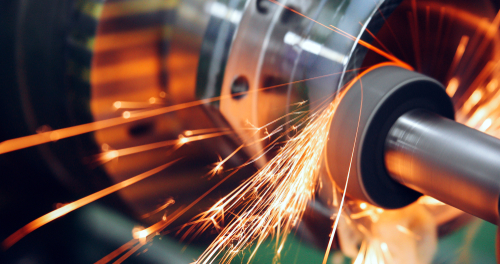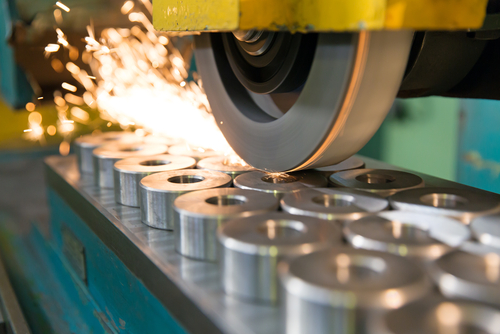 In most cases, a die cast product has to undergo the last processes called surface finishing prior to its assembly. The surface finish can offer durability, protection, as well as a decorative appearance to a die cast component. Since surface finishing choices range from the appearance to performance, always it is better to communicate your application requirements with your die caster during the design stage itself. That is because specific features of several die-cast component designs affect the surface finish quality. For instance, the parting lines, gates, and ejector pins can affect the output. Therefore, it is better to evaluate your best design as well as surface finishing options with due consultation with your die casting partner.
In most cases, a die cast product has to undergo the last processes called surface finishing prior to its assembly. The surface finish can offer durability, protection, as well as a decorative appearance to a die cast component. Since surface finishing choices range from the appearance to performance, always it is better to communicate your application requirements with your die caster during the design stage itself. That is because specific features of several die-cast component designs affect the surface finish quality. For instance, the parting lines, gates, and ejector pins can affect the output. Therefore, it is better to evaluate your best design as well as surface finishing options with due consultation with your die casting partner.
Many different types of surface finishing options are offered for die-cast parts. Generally, die casters can handle various surface finishing requirements. Depending on your requirement, any of the following shall apply.
Anodizing
The anodizing output is a protective coating that is non-conductive and seals a die-cast component. It comes in an array of colors and is an extremely affordable choice to improve durability as well as resistance to corrosion of the part.
Powder Coating
Powder coating is one of the popular surface finishes out there. It is tough to achieve as it is cured at relatively higher temperatures. In general, it is ding and scratch resistant. It is available in many different colors, textures, as well as gloss levels. Considering that it is appropriately cured, an extremely controlled die casting procedure is important.
Vibratory Finishing
The vibratory finishing technique allows to deburr, burnish, clean, as well as brighten workpieces or parts. During this surface finishing process, components are put into a vibratory machine to obtain the preferred effect. The contents are vibrated as part of that. The process can finish the internal features of a component, like holes, as well as is less loud and faster.
Impregnation
Impregnation seals the porosity in metal components. It creates watertight parts. It is an extremely viable surface finishing option to enhance the yield as well as reduce the scrap. Plus, it is a wonderful option to use post machining when removing a die-cast component’s ‘skin’ to make it leak-free.
Polishing
Polishing requires abrasive tools’ use in order to smooth the surface of a component. It is usually performed by abrasive discs or belts and is used to level the surfaces, get rid of scratches as well as pits, and polish a part’s surface leaving a lined or brushed finish.
Determine Whether your Components Require Surface Finishes
There have been some advancements in alloys which have let die casters provide raw die cast components where a further surface finish would usually have been necessitated. Depending on a die-cast component’s metals or materials, it may differ. Usually, die casters say that zinc castings do not really necessitate further surface finish or that the components can be used in a raw state.  However, further surface treatments like powder coating as well as E-coat can be applied, too, if they are required to improve the finish of the zinc parts.
However, further surface treatments like powder coating as well as E-coat can be applied, too, if they are required to improve the finish of the zinc parts.
There have been many advancements in aluminum and zinc alloys that allows for parts without the requirement of additional surface finish, which save a lot of costs and reflects on the end product’s price tag. It is not applicable as such to each specific application. Then again whether the material requires surface finish or performs well with it is one of the factors that need to be considered. In this regard, it is best to talk with your die casting company for more information.
The performance of the surface finish of your choice will be in part dependent upon the quality of either the substrate or the die cast part. There are important parameters that have to be monitored by die casters during the metallurgical casting process. When you collaborate with a die casting company, you have to talk about how it plans to monitor those parameters for if there is control over the process and it is appropriately monitored, the foundry actually manufactures quality into the part.
In addition, note this particular process is in applied scenarios more than merely die casting. It starts with a systematic tool design based upon the manufacturability of the component. So getting your die casting firm involved in the process early on will not be a bad idea so that its design is done properly with due procedures.
Surface Finishing at Pacific Die Casting
Pacific Die Casting handles the various surface finishing requests from our clients through our secondary department. We have a rich and varied clientele who seek surface finishing for die casting applications or projects. Prior to entering into a project with us, have a conversation with one of our engineers to choose the processes better suited to your application.
Give your part that “final touch”. Pacific Die Casting’s secondary department can handle many different requests.
The secondary shop can accomplish these processes and more:
- Anodizing
- Painting
- Powder coating
- Plating
- Media blasting
- Vibratory finishing
- Polishing
- Brush Finishing
- Impregnating
